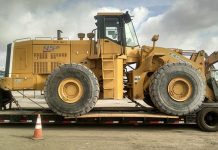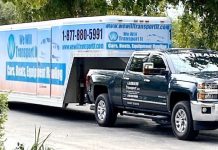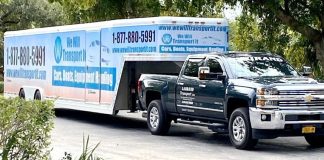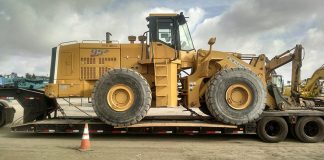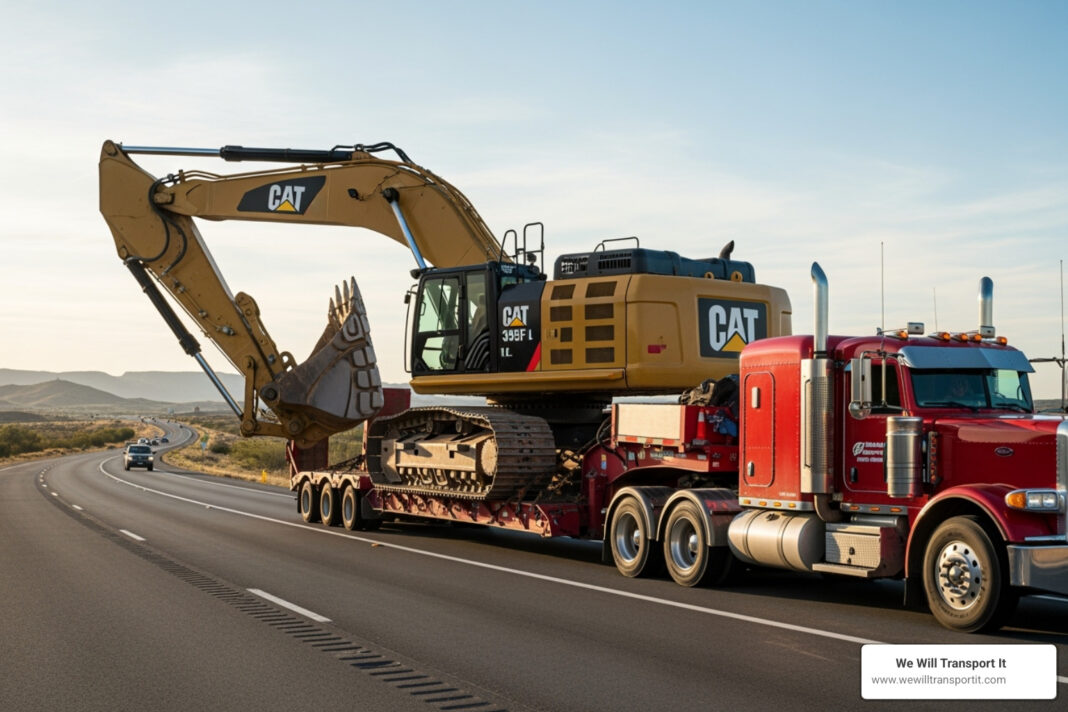
Your Comprehensive Guide to Moving Heavy Machinery
Equipment Transport is the specialized shipping of heavy machinery, construction equipment, and oversized loads. Whether moving a 500-pound forklift or a 250,000-pound excavator, the process requires expert handling, proper permits, and the right equipment to ensure safe delivery.
Key Equipment Transport Essentials:
- Trailer Types: RGN, flatbed, step-deck, and lowboy trailers accommodate various equipment sizes.
- Weight Capacity: Services handle equipment from 500 lbs to over 250,000 lbs.
- Cost Factors: Pricing is affected by distance, equipment size, permits, and seasonal demand.
- Timeline: Most shipments require at least two weeks of advance booking for permits and scheduling.
- Safety Requirements: Professional securement, experienced drivers, and full insurance are mandatory.
Moving heavy equipment involves more than just loading it onto a truck. It requires understanding complex state-by-state regulations, securing permits for oversized loads, and coordinating logistics like route planning and pilot car escorts. The average cost can range from $4.87 per kilometer for shorter distances to $1.61 per kilometer for hauls over 500 kilometers.
Professional transport companies manage the entire logistics puzzle, from selecting the right specialized trailer to handling the paperwork for legal transport across state lines.
I’m William Meyer, founder of We Will Transport It. Since 2011, I’ve helped businesses steer the complexities of Equipment Transport with dedicated, hands-on service. My background as a driver revealed the service gaps in equipment shipping, inspiring me to build a company that prioritizes clear communication and customer care.

Understanding the Scope of Heavy Equipment Transport
When moving heavy machinery, the first step is understanding the scope of the job. Equipment transport is a specialized field that requires matching the right trailer to your specific piece of equipment for a safe and efficient move.
Common Types of Machinery We Move
We handle a vast range of machinery, from small 500-pound forklifts to massive 250,000-pound excavators. No two shipments are exactly alike, which makes diversity a core part of equipment transport.
Construction equipment is a major part of our business. We regularly transport Bulldozers, Excavators, and various types of Cranes, including Telescopic Cranes and Hammerhead Cranes. We also move backhoes, skid steer loaders, boom lifts, asphalt pavers, concrete mixers, and pile drivers.
Agricultural machinery transport is time-sensitive, as farmers depend on their equipment for their livelihood. We transport Tractors of all sizes, combines, and various farm implements that keep America’s farms running.
Industrial machinery covers everything from manufacturing equipment to specialized plant machinery. We also handle Motor Graders, Wheel Loaders, scissor lifts, trenchers, and even items like RVs and Oversize Trucks.
Accurate dimensions are crucial for planning and pricing. We recommend using reliable tools like Ritchie Specs to gather precise measurements. The more details you provide about your equipment’s make, model, dimensions, and weight, the more accurate your quote will be.
The Right Trailer for the Job
Choosing the right trailer is critical for safety, cost, and legal compliance in equipment transport.

-
Flatbed trailers: These versatile 53-foot trailers have a flat deck for easy loading from any side. They handle equipment up to 48,000 pounds and 8.5 feet high, making them ideal for standard heavy equipment.
-
Step-deck trailers: Also known as drop-deck trailers, these feature multiple levels to lower the cargo, allowing transport of equipment up to 11 feet high while staying within legal height limits.
-
Removable Gooseneck (RGN) trailers: These heavy-duty trailers detach at the front, creating a ramp for equipment to drive directly onto the deck. The low-lying “well” accommodates heights up to 11.6 feet and weights often exceeding 150,000 pounds.
-
True lowboy trailers: Designed for maximum stability with an extremely low deck height, lowboys typically handle weights from 40,000 to 80,000 pounds with deck lengths from 24 to 29.6 feet.
-
Hot shot trailers: These are used for expedited or regional transport of lighter equipment, with a maximum capacity of 15,000 pounds and lengths around 40 feet.
-
Conestoga trailers: Combining a flatbed’s versatility with a rolling tarp system for weather protection, these are ideal for sensitive equipment. They are 48 to 53 feet long with a 48,000-pound capacity.
Our expertise lies in matching your equipment to the perfect trailer for safe and legal Oversize Load Transport. We don’t just move your equipment—we move it right.
The Logistics of Moving Heavy Equipment
Moving heavy equipment successfully requires navigating a complex web of regulations and preparation. Understanding the logistics behind Equipment Transport is key to a smooth process.
Navigating Regulatory Requirements
Transporting heavy equipment is governed by strict rules that vary by state. While Federal DOT rules set baseline standards, each state has its own specific regulations.
-
State-by-state regulations: A route may cross multiple states, each with different rules for operating hours, escort requirements, and permit fees. For example, Kansas allows legal widths up to 8’6″ and heights up to 14′, but with permits, you can go up to 16’6″ wide and 18′ high. In contrast, Colorado Springs prohibits oversized loads on Sundays.
-
Oversize transport permits: These are required for any load exceeding legal dimensions. The permit process can take anywhere from a few days to several weeks, depending on the load size and route. We handle all applications to ensure compliance.
-
Pilot cars and escorts: These become mandatory when equipment exceeds certain dimensions. In Kansas, loads over 16’6″ wide on four-lane highways need two escort vehicles. These trained professionals manage traffic and communicate with the driver to ensure safety.
-
Route planning and surveys: We analyze every mile of the route, checking for bridge clearances, road construction, weight restrictions, and tight turns. For complex moves, we may survey the route in person to identify potential issues before transport begins.
-
Bridge laws: We adhere to strict bridge laws, calculating not just total weight but also its distribution across axles to avoid stressing infrastructure.
When Transporting Heavy Equipment to All 50 States, this regulatory maze becomes even more complex, which is why our experience is so valuable.
How to Prepare Your Heavy Equipment for Transport
Properly preparing your equipment is essential to prevent delays and damage.
-
Clean your equipment: Clean surfaces allow for a better grip for tie-down equipment and enable a thorough pre-shipment inspection to document any existing wear.
-
Secure loose components: Retract and lock booms, buckets, and other attachments. Secure or remove any parts that can move or vibrate loose, such as mirrors and antennas.
-
Get accurate dimensions: Use reliable tools like Ritchie Specs to provide precise height, width, length, and weight. Incorrect measurements can lead to using the wrong trailer or permits.
-
Disconnect batteries: This prevents accidental starts and protects electronics. Also, check for any fluid leaks that could cause environmental issues during transit.
-
Document the pre-shipment condition: We take detailed photos and complete a comprehensive inspection report (Bill of Lading) before loading. This documentation is crucial for insurance purposes.
For winter moves, Preparing Oversize Trucks for Transport in the Winter requires extra steps like checking antifreeze levels. Additionally, ensure pickup and delivery locations have stable, level ground for safe loading and unloading. If your equipment is inoperable, let us know so we can arrange for winching or crane services.
Explaining Costs and the Booking Process
Understanding the financial and procedural aspects of equipment shipping is key to a smooth experience. Here’s what you need to know about pricing and how to book your equipment transport.
Factors Influencing Equipment Transport Costs
The cost of equipment transport is calculated based on several key factors that make each shipment unique.

-
Size and Weight: The equipment’s dimensions are the biggest factor. Moving a 500-pound forklift is far less complex than a 250,000-pound excavator, which requires specialized trailers and permits.
-
Distance: Shorter shipments (under 500 km) average around $4.87 per kilometer, while longer hauls (over 500 km) are more efficient, dropping to about $1.61 per kilometer.
-
Route and Location: Difficult terrain, city traffic, and remote pickup or delivery locations can increase costs due to extra planning and logistical challenges.
-
Timing and Seasonality: Transport during winter or peak construction seasons may cost more due to weather challenges and higher demand.
-
Fuel Prices: Fluctuating diesel costs directly impact transport prices.
-
Permits and Escorts: Special permits and pilot cars are required for oversized loads, adding to the overall expense.
-
Equipment Condition: Non-running machinery may require cranes or winches for loading, which increases the cost.
We always strive to find the most Cheap Way to Ship Heavy Items without compromising on safety or service quality.
Your Step-by-Step Guide to Booking Transport
Our booking process is designed to be as straightforward as possible.
-
Gather Equipment Details: Collect the make, model, year, and exact dimensions (height, width, length, weight). Use a reliable source like Ritchie Specs for accuracy. Note whether the equipment is operational.
-
Request a Quote: Call us or fill out our online form with your equipment details. Our Vehicle Shipping Calculator can provide a quick estimate. We’ll create a personalized quote based on your specific needs.
-
Compare and Research: We encourage you to do your homework. Look beyond price and consider a carrier’s experience, safety record, insurance, and customer reviews.
-
Schedule Pickup: We’ll work with you to find a convenient pickup date. Book at least two weeks in advance for oversized loads to allow time for securing permits.
-
Finalize Paperwork: We handle all permits and documentation. The most important document is the Bill of Lading, which records your equipment’s condition at pickup and serves as a detailed receipt.
-
Make Payment: We use secure payment methods to protect your transaction and information.
Choosing the Right Partner for Your Haul
Selecting a qualified and reliable transport company is the most critical decision for your equipment transport. You need a partner with the right skills, experience, and track record to handle your valuable assets with care.
Key Considerations for Selecting a Transport Company
When entrusting your equipment to a carrier, here are the key factors that separate the professionals from the rest.
-
Experience: Heavy hauling requires years of experience to understand the nuances of loading different machines and navigating challenging routes. We Will Transport It has been perfecting this craft since 2011.
-
Licensing and Credentials: A reputable carrier must be fully licensed, bonded, and insured. We display our We Will Transport It Credentials to demonstrate our commitment to legal and safe operations.
-
Insurance Verification: Your equipment is a significant investment and must be protected. Verify that the carrier has comprehensive cargo liability insurance that covers your equipment’s full value. Ask to see the policy details.
-
Service Capabilities: Ensure the company has the right trailers and expertise for your specific load. We offer comprehensive services, from Heavy Machinery Shipping to specialized Manufacturing Equipment Haulers.
-
Customer Reviews: Check independent review sites to see honest feedback about a company’s reliability, communication, and professionalism.
-
Communication and Support: The best companies provide dedicated agents and 24/7 support. Clear, consistent communication is essential for a stress-free experience.
Ensuring Safety and Security During Your Equipment Transport
We treat every piece of equipment like our own, because we understand your livelihood depends on it arriving in perfect condition.

-
Proper Loading: Our skilled professionals use calculated, deliberate techniques, whether driving operable equipment onto an RGN or coordinating crane lifts for non-running machinery.
-
Securement Standards: We use industrial-grade chains, straps, and tie-downs, strategically placed based on weight distribution and center of gravity. Drivers perform regular checks throughout the journey.
-
Experienced Drivers: Our specialist drivers are experts in hauling oversized loads, managing weight distribution, and handling various road conditions to keep your equipment secure.
-
Real-Time Tracking: Our tracking systems allow you to monitor your equipment’s progress from pickup to delivery, and our agents are always available for updates.
-
Comprehensive Insurance: We ensure all equipment is insured to its maximum value. We also recommend understanding your freight insurance options for complete peace of mind.
-
Pre-Shipment Inspection: Our detailed Bill of Lading, complete with photos, serves as a comprehensive record of your equipment’s pre-transport condition, protecting all parties involved.
Frequently Asked Questions about Equipment Transport
Here are answers to the most common questions our customers have about equipment transport.
How far in advance should I book my equipment transport?
We recommend booking at least two weeks in advance. This timeline is crucial for several reasons:
-
Permit Acquisition: If your equipment is oversized, we need to secure special permits from every state on the route. This process can take anywhere from a few days to over a week.
-
Peak Seasons: During busy construction or harvest seasons, demand for transport services is high. Booking early ensures better availability and scheduling.
-
Resource Scheduling: We need time to schedule the specific trailer and experienced heavy haul driver required for your job.
While we do our best to accommodate last-minute requests, providing more lead time ensures smoother service and often better pricing.
What happens if my equipment is damaged during transport?
While damage is rare, we have a clear process in place to protect you.
-
The Pre-Shipment Inspection is Key: The detailed Bill of Lading (BOL) we complete before loading, including photos of any pre-existing wear, is crucial. It serves as a baseline for the equipment’s condition.
-
Document Damage Immediately: If you notice any new damage upon delivery, note it on the BOL before signing. Take clear photos from multiple angles. This documentation is essential for a claim.
-
Insurance Claims Process: We carry comprehensive cargo liability insurance that covers your equipment’s full value. If damage occurs, we will guide you through our straightforward claims process to make things right.
Understanding your freight insurance options is also important. While our liability covers negligence, you may consider full value coverage for protection against all transit risks.
Can you transport non-running or inoperable equipment?
Yes, we handle non-running equipment frequently. Whether it’s a broken-down bulldozer or a tractor with engine issues, we have the solutions to move it.
-
Specialized Loading: For equipment that cannot be driven onto a trailer, we use powerful winches or coordinate crane services for loading and unloading.
-
Disclose the Condition Upfront: It is critical to inform us that your equipment is inoperable when you request a quote. This allows us to dispatch the correct equipment and personnel, avoiding delays and additional costs.
-
Preparation is Required: We may ask you to prepare the non-running equipment by inflating tires or securing loose parts to ensure a safe loading process.
Whether you need Heavy Equipment Transport in Texas or nationwide, we handle both running and non-running equipment with the same professional care.
Conclusion: Your Next Move for Stress-Free Transport
Moving heavy machinery is a complex task. Between selecting the right trailer, navigating state permits, and ensuring a safe arrival, equipment transport can be a significant challenge. You have a business to run, and you shouldn’t have to become an expert in DOT regulations and bridge laws.
This is where a professional logistics partner becomes invaluable. We handle the complexities so you can focus on your work.
-
Expertise Makes a Difference: We know which trailer, route, and permits are needed for your specific machine, keeping your project safe and on schedule.
-
Safety is Our Priority: Our experienced drivers, proven loading techniques, and industrial-grade securement turn a potentially risky process into a smooth journey.
-
Cost-Effective Solution: While there is an upfront cost, professional transport prevents expensive mistakes. A single permit violation or damaged component can cost far more than our services.
-
Peace of Mind: Most importantly, you can rest easy knowing your valuable equipment is in expert hands.
At We Will Transport It, we have built our reputation on making equipment transport feel effortless. We manage every detail, from permits and escorts to real-time tracking and delivery coordination. We treat your equipment like our own.
Your heavy machinery deserves professional care. Let us take the stress out of your next move.
Get a free quote for your heavy equipment transport needs today!

